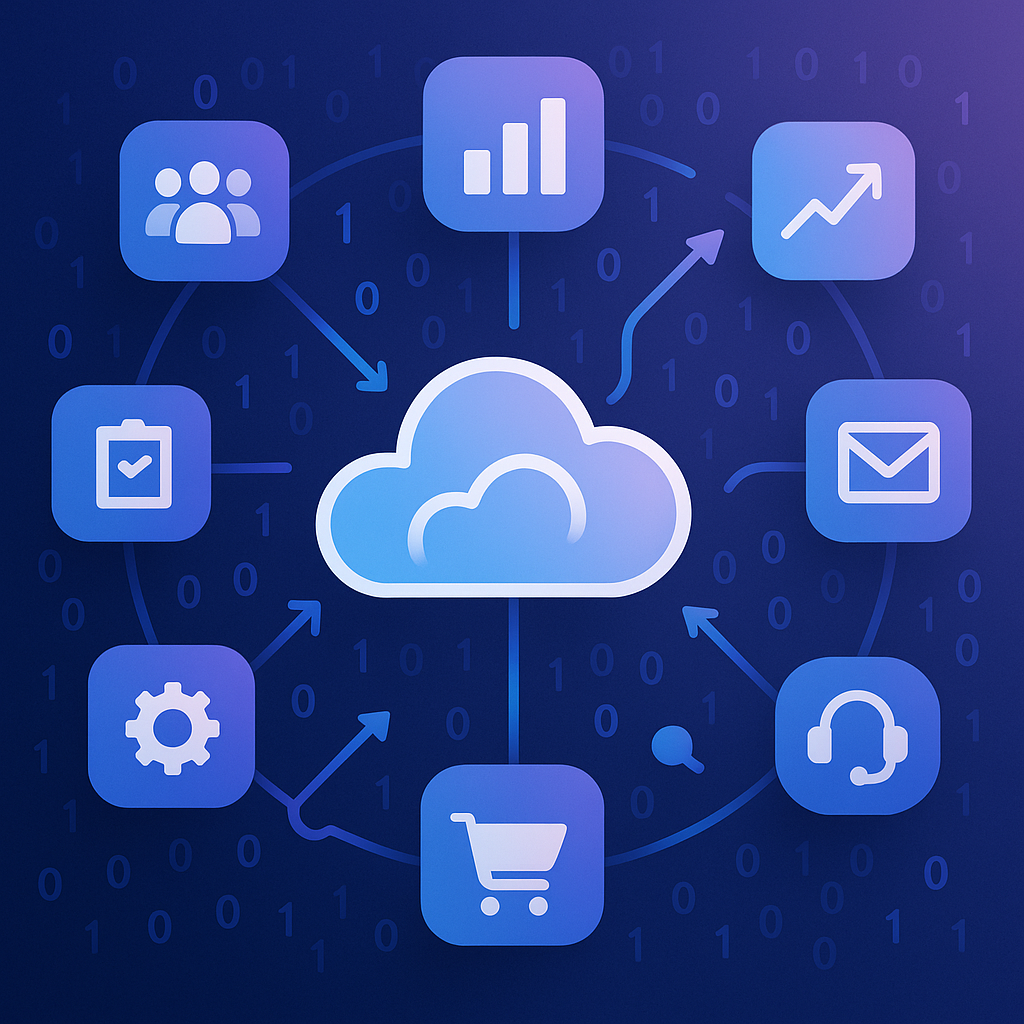The software-as-a-service (SaaS) revolution has changed the way entrepreneurs build and scale their companies. Instead of buying expensive licenses or maintaining complex on‑premise servers, today’s business leaders subscribe to cloud‑based platforms that automatically update, scale on demand and seamlessly integrate with other apps. According to Gartner’s cloud spending forecast, global SaaS revenue is projected to reach US$247.2 billion in 2024 as more organizations adopt subscription‑based software for mission‑critical functions. For startups and small businesses, SaaS tools offer enterprise‑grade capabilities at a fraction of the cost, allowing founders to focus on innovation rather than IT.
In this comprehensive guide, we examine the top 10 SaaS tools every entrepreneur needs in 2025. The primary keyword, “SaaS tools,” is woven throughout this article, and secondary keywords – such as “CRM software,” “project management apps,” and “marketing automation platforms” – are naturally integrated. E
ach entry includes definitions, examples, tables, and statistics so that you can make informed decisions about which software will help your business thrive. Read on to discover how cloud‑based services can transform everything from sales and marketing to finance and customer support.
Why Entrepreneurs Depend on SaaS Tools in 2025
Before diving into individual platforms, it’s important to understand why SaaS tools have become so indispensable. Entrepreneurs value these solutions because they are:
- Cost‑effective and scalable. SaaS subscriptions are typically billed monthly or annually and can be adjusted to match business growth. There’s no need to purchase expensive hardware or manage upgrades.
- Easy to integrate. Leading SaaS platforms include application programming interfaces (APIs) and pre‑built integrations with other tools. This allows small companies to build sophisticated tech stacks without custom coding.
- Accessible anywhere. Because data is stored in the cloud, team members can collaborate from anywhere in the world using desktop, mobile or web apps.
- Updated automatically. Vendors continuously improve their software, providing security patches and new features without requiring user intervention.
- Backed by analytics and automation. Modern SaaS tools incorporate artificial intelligence (AI) and machine learning (ML) to automate repetitive tasks and surface insights.
For entrepreneurs, these advantages translate into lower operating costs, faster innovation cycles, and enhanced customer experiences. In the following sections, we explore 10 of the most valuable SaaS platforms, highlighting how each one supports different aspects of running a successful business.
1. HubSpot: Comprehensive CRM and Marketing Platform
HubSpot is a powerhouse of tools that combine customer relationship management (CRM), marketing automation, sales enablement and service into a single platform. Entrepreneurs can use HubSpot’s free CRM to store contacts, track deals, and analyze sales pipelines. The marketing hub offers email sequences, social media scheduling, and blog publishing. According to Woblogger’s review of essential SaaS tools, HubSpot integrates with Gmail, Outlook, WordPress, eCommerce platforms and more, making it the backbone of many startups’ tech stacks.
- Key features: contact management, lead scoring, email tracking, landing page creation, marketing automation workflows, and detailed analytics dashboards.
- Pricing: The core CRM is free for unlimited users. Marketing, Sales and Service hubs start at US$15 per month each and scale based on user count and features.
- Best for: Entrepreneurs seeking an all‑in‑one solution for attracting prospects, nurturing leads and managing customer relationships.
- External reference: HubSpot’s widely recognized inbound marketing methodology has been adopted by businesses around the world. A Harvard Business Review study found that companies using inbound strategies achieve 3× higher return on investment (ROI) than those relying solely on outbound advertising.
2. Trello: Visual Project Management
When it comes to task management, Trello is a favorite among startups for its intuitive Kanban boards. Users create boards for projects, add lists for stages such as “To Do,” “In Progress” and “Done,” and then drag cards representing tasks through the workflow. Trello integrates with Slack, Google Drive, HubSpot and Zoom, making it easy to turn conversations into actionable tasks.
- Key features: drag‑and‑drop task cards, checklists, due dates, file attachments, labels and color coding, plus a library of automation rules (“Butler”) for repetitive actions.
- Pricing: Free with unlimited cards and boards. Paid plans start at US$5 per user per month and unlock features such as advanced checklists, dashboard views and priority support.
- Best for: Teams who need a flexible, visual project management tool without steep learning curves.
- Example: A marketing team might have a Trello board with lists for brainstorming, content creation, editing, and publishing. Each card contains a blog post idea, assigned team members, and deadlines.
3. Slack: Unified Team Communication
Slack replaces messy email threads with organized channels, direct messages and integrations with more than 2,000 apps. Entrepreneurs can create channels for different projects or departments, share files, jump into audio or video “huddles,” and connect their calendars, CRM systems and code repositories. As Woblogger notes, Slack’s free plan is generous, while paid tiers add advanced features like compliance exports and enterprise security.
- Key features: real‑time messaging, thread conversations, voice and video calls, searchable history, app integrations, workflow builder and custom emojis.
- Pricing: Free plan with limited message history. The Pro plan starts at US$8.75 per user per month, unlocking unlimited message storage, 10× more integrations and group video calls.
- Best for: Companies that need quick collaboration across remote teams and want to centralize communications.
- Statistics: Slack’s own data shows that teams experience a 32 % reduction in meetings and a 24 % decrease in email volume after adopting the platform.
4. QuickBooks Online: Accounting and Finance Management
Financial clarity is critical for entrepreneurs. QuickBooks Online helps manage income, expenses, invoicing, payroll and reporting. It automates recurring invoices, tracks taxes, and integrates with PayPal, Shopify and Square for seamless transactions. By keeping financial data in one place, founders avoid costly errors and save time during tax season.
- Key features: invoicing and payments, expense categorization, real‑time cash flow reports, payroll management, mileage tracking and inventory management.
- Pricing: Simple Start plan begins at US$19 per month, with higher tiers offering more users and advanced inventory features.
- Best for: Entrepreneurs who want an easy‑to‑use accounting solution that scales with business growth.
- External reference: The Small Business Administration estimates that automated accounting software saves small firms up to 120 hours per year compared with manual bookkeeping.
5. Notion: All‑in‑One Workspace
Notion blends note‑taking, task management, wikis, databases and calendars into one flexible workspace. Startups can build knowledge bases, manage hiring pipelines or create product roadmaps within Notion. Its modular blocks allow you to embed tables, images, code snippets and more, while integration with Slack, Google Drive and GitHub keeps all resources aligned.
- Key features: customizable pages, kanban boards, table databases, calendars, timeline views, templates and powerful markdown support.
- Pricing: Free for personal use with basic features. The Team plan starts at US$8 per user per month and provides advanced permissions and unlimited guests.
- Best for: Entrepreneurs needing a single source of truth for documents, projects, and processes.
- Case study: A product startup uses Notion as a centralized hub for design specs, engineering tasks, meeting notes, and employee onboarding manuals.
6. Google Workspace: Collaborative Productivity Suite
Google Workspace (formerly G Suite) includes email (Gmail), document editing (Docs), spreadsheets (Sheets), presentations (Slides), video conferencing (Meet), file storage (Drive) and scheduling (Calendar). Its real‑time collaboration means multiple team members can co‑edit documents simultaneously. Advanced security features like 2‑factor authentication protect data, while the Business Starter plan begins at just US$6.30 per user per month.
- Key features: robust email and calendar, real‑time document collaboration, large cloud storage, AI‑powered search and meeting scheduling, plus hundreds of third‑party integrations.
- Pricing: Starts at US$6.30 per user per month for Business Starter, scaling up to Business Plus with advanced compliance controls.
- Best for: Any business that needs a full productivity suite with strong collaboration and reliability.
- External reference: A Forrester Total Economic Impact report found that organizations adopting Google Workspace achieve a 331 % ROI over three years due to improved productivity.
7. Canva Pro: Graphic Design Made Easy
Visual content is essential for brands. Canva Pro offers thousands of templates for social media posts, presentations, infographics and more. Entrepreneurs without design backgrounds can create polished graphics with its drag‑and‑drop interface. Advanced features like the Magic Resize tool, brand kits and background remover make Canva Pro a favorite among marketing teams.
- Key features: template library, stock photos and videos, brand kits (fonts/colors), animation, team collaboration, and one‑click resizing for multiple platforms.
- Pricing: The basic plan is free; Canva Pro starts at about US$55 per user per year.
- Best for: Small businesses needing professional design tools without hiring an in‑house designer.
- Statistics: Studies show that content with relevant images gets 94 % more views than text‑only posts, highlighting the importance of tools like Canva.
8. Dropbox: Secure File Storage and Sharing
Dropbox pioneered cloud storage and remains a top choice for file synchronization. Entrepreneurs can store documents, images, and videos in the cloud and share them via secure links. The platform integrates with Slack, Zoom, Trello, Adobe Creative Cloud and more, enabling seamless workflows. Paid plans provide large storage quotas and features like file recovery, watermarking and document signing.
- Key features: automatic syncing across devices, granular permission controls, file version history, Smart Sync to free local storage, and integrated e‑signature (HelloSign).
- Pricing: Free plan includes 2 GB of storage. Dropbox Plus (2 TB) costs about US$9.90 per month; business plans offer unlimited storage.
- Best for: Businesses that need reliable file storage with strong security and collaboration features.
- External reference: Gartner consistently rates Dropbox as a “Leader” in the content collaboration platforms magic quadrant due to its ease of use and enterprise‑grade security.
9. Zoom: High‑Quality Video Conferencing
Video meetings are critical for distributed teams and client communication. Zoom offers HD video and audio, screen sharing, meeting recording, breakout rooms, webinars and built‑in chat. It integrates with Google Calendar, Slack, Trello and HubSpot, making it easy to schedule and join calls from within other apps. While the free plan includes 40‑minute meetings, the Pro plan extends sessions and adds advanced features.
- Key features: HD video and audio conferencing, virtual backgrounds, breakout rooms, chat, webinar hosting, and transcription.
- Pricing: Free plan with 40‑minute meeting limit. Pro starts at around US$13.33 per user per month; enterprise packages add webinar and room connectors.
- Best for: Remote teams and businesses that rely on video communication for sales demos, training and collaboration.
- Example: A SaaS startup uses Zoom to onboard clients via screen sharing and live training, reducing travel costs and accelerating revenue.
10. Zendesk: Customer Support Made Simple
Customer support can make or break a young company. Zendesk provides an omnichannel help desk that consolidates inquiries from email, chat, social media and phone into a single dashboard. Ticket management, automation, analytics and a customizable help center empower small teams to deliver enterprise‑level service. Zendesk integrates with eCommerce platforms, CRMs and communication tools to provide context for every customer interaction.
- Key features: ticketing system, automated workflows, knowledge base, customer feedback surveys, AI‑powered chatbots, and more than 1,000 integrations.
- Pricing: Suite Team plan starts at US$19 per agent per month; higher tiers add automation and artificial intelligence features.
- Best for: Entrepreneurs who need a scalable support platform that grows with their customer base.
- External reference: Research from Bain & Company shows that companies improving customer retention by just 5 % can increase profits by 25–95 %, underscoring the value of effective support.
Comparative Table of SaaS Tools
| SaaS Tool | Main Purpose | Key Features | Starting Price (USD) |
|---|---|---|---|
| HubSpot | CRM & Marketing | Contact management, email automation, analytics | Free; paid from $15/month |
| Trello | Project management | Kanban boards, checklists, automation | Free; paid from $5/user/month |
| Slack | Team communication | Channels, messaging, integrations | Free; Pro from $8.75/user/month |
| QuickBooks Online | Accounting | Invoicing, payroll, reporting | $19/month |
| Notion | Workspace/Knowledge base | Pages, databases, templates | Free; Team from $8/user/month |
| Google Workspace | Productivity suite | Email, docs, sheets, video conferencing | $6.30/user/month |
| Canva Pro | Design | Templates, animations, brand kits | $55/year |
| Dropbox | File storage | Sync, permissions, versioning | Free; Plus $9.90/month |
| Zoom | Video conferencing | HD meetings, recordings, webinars | Free; Pro $13.33/user/month |
| Zendesk | Customer support | Omnichannel ticketing, automation | $19/agent/month |
FAQs About SaaS Tools for Entrepreneurs
What are SaaS tools and why are they essential for entrepreneurs?
SaaS tools are cloud‑based software applications delivered over the internet on a subscription basis. They allow businesses to access powerful capabilities without installing anything on local servers. For entrepreneurs, SaaS tools are essential because they minimize upfront expenses, scale with growth and provide enterprise‑grade features that level the playing field with larger competitors. SaaS applications also enable remote collaboration and integrate easily with other tools, creating a cohesive digital ecosystem. By using SaaS solutions, founders can automate routine tasks, gain insights from real‑time analytics and focus on strategic decision‑making rather than software maintenance.
How should entrepreneurs select the right SaaS tools for their business?
Choosing the right SaaS tools begins with understanding your business needs. Start by mapping your core processes – marketing, sales, finance, communication and customer support – and identify pain points. Next, evaluate how potential tools integrate with your existing stack and whether they offer APIs or native connections to other apps. Look at pricing models and ensure the cost aligns with your budget. Trial periods or free plans allow you to test the user experience. Check customer support options, security certifications and user reviews to gauge reliability. Finally, consider the vendor’s product roadmap to ensure the tool will continue to innovate alongside your business.
Are free SaaS tools effective for startups?
Many SaaS vendors offer free plans that are surprisingly robust, making them ideal for early‑stage startups. Platforms like HubSpot CRM, Trello, Slack and Notion provide generous features at no cost. These freemium models allow startups to build their workflows, test functionality and onboard teams without financial risk. However, as your business grows, you may need to upgrade to paid tiers to access advanced analytics, larger storage limits or automation. Free plans are effective for learning and experimentation, but planning for future costs ensures there are no surprises when you need to scale.
What are some best practices for integrating SaaS tools into a business?
When integrating SaaS tools, follow a phased approach: (1) clearly document your current processes and identify integration points; (2) choose platforms that offer native integrations or open APIs; (3) start with a small pilot to test data flows and user experience; (4) train your team on best practices and provide documentation or tutorials; (5) monitor performance and adjust workflows based on feedback. Automating data transfers between systems reduces manual data entry and errors. Additionally, establish governance policies for access control and data security to ensure compliance with privacy regulations.
How will SaaS tools evolve over the next decade?
The next decade will see SaaS tools become increasingly intelligent and specialized. AI and machine learning will move beyond chatbots and predictive analytics to deliver personalized experiences, autonomous decision‑making and real‑time insights【664022286587271†L283-L297】. Agentic AI platforms will act as virtual assistants that proactively handle tasks and recommend actions【900369551813574†L620-L644】. Vertical or micro‑SaaS solutions will cater to niche industries, providing tailored workflows and deep domain expertise. Security and responsible AI practices will be differentiators as customers demand transparency and ethical data usage. Overall, SaaS tools will continue to democratize access to cutting‑edge technology, helping entrepreneurs compete on a global stage.
Conclusion
Entrepreneurial success in 2025 and beyond requires leveraging the right digital tools. The SaaS platforms highlighted in this article – from HubSpot’s CRM and marketing automation to Zendesk’s omnichannel support – provide the infrastructure for scaling sales, boosting productivity, managing finances and delighting customers. By adopting a strategic mix of these services, founders can reduce overhead, improve collaboration, and make data‑driven decisions that fuel sustainable growth.
Before committing to any platform, assess your specific needs, test free plans and ensure the tools integrate with each other. Remember that technology should support your business goals, not dictate them. Ready to transform your business with best‑in‑class SaaS tools? Explore each solution, experiment with features and start building the tech stack your entrepreneurial journey deserves. [Link to related article: How AI Is Transforming Small Business Operations in 2025]








